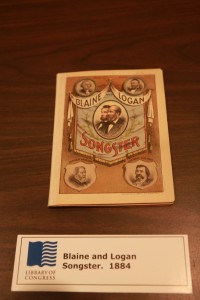(This is the second in a series of posts featuring presidential campaign items from the Library’s collections. Read the first here.)
Politics and music have enjoyed a rather persistent relationship. And it’s never more evident than during campaign season when candidates use music to connect with voters. The tradition can be seen as far back as the presidential election of George Washington, although he was uncontested.
Often set to popular songs of the day, during the early 19th century, most tunes were in celebration of the candidate and not necessarily about campaign issues. It wasn’t until the election of 1840 that the songs became issue-based and were really used to try to affect the outcome of an election. During this time, partisan politics was well developed, and the Democrats and Whigs – the two major parties of the day – used the power of song as a campaign tool.
One of the best-known campaign songs was inspired by William Henry Harrison: “Tippecanoe and Tyler Too” touted Harrison as a war hero at the 1811 Battle of Tippecanoe, and his vice president, John Tyler. The “media blitz” that resulted sang Harrison into his presidency.
Both parties also published “songsters,” pocket-sized books perfect for an impromptu street corner rally. The earliest songsters included only lyrics printed along with the titles of well-known tunes to which they were to be sung. Two songsters from the 1844 contest between James K. Polk (1795–1849) and Henry Clay (1777–1852) offered their followers relevant new words for old standards like “Yankee Doodle.” By 1884, some songsters would include written music arrangements, including the “Blaine-Logan Songster” that served to promote a specific ticket.
These songs connected with voters through their leisure activities. Families would buy the music and sing the songs together.
So, who wrote these songs? Writers were often hired by the campaign to put together something catchy that would stick with voters so they would remember the candidates’ names – “We Like Ike.” Well-known musicians were also sometimes enlisted to compose a ditty: “Harding You’re the Man for Us” (1920) was written and sung by Al Jolson; Ira Gershwin reworked “It Ain’t Necessarily So” from “Porgy and Bess” for Adlai Stevenson in 1952.
By the last quarter of the 20th century, political parties turned more and more to newspapers, radio and television, which provided immediate access to mass audiences. Increasingly, candidates began to adopt existing songs from popular recording artists as their own. Although composers still wrote music in celebration of their favorite candidates, sheet music became less and less significant in campaigning.
Make sure to check out the Library’s online exhibition, “Voices, Votes, Victory: Presidential Campaign Songs,” for more.




October 28, 2012 at 2:13 pm
Apprecaited this!